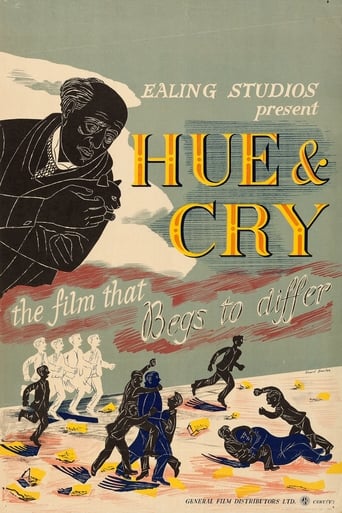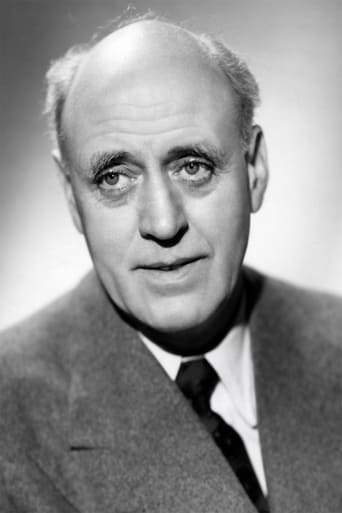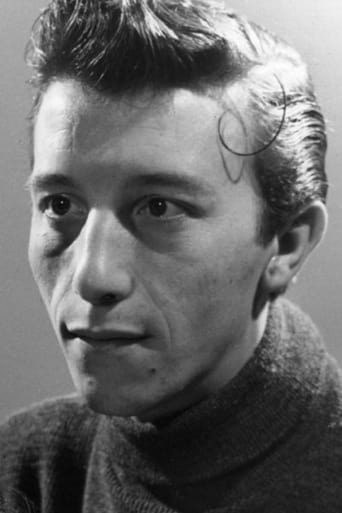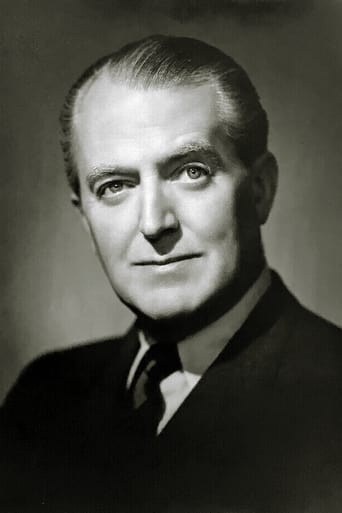Hue and Cry (1947)
A gang of street boys foil a master crook who sends commands for robberies by cunningly altering a comic strip's wording each week, unknown to writer and printer. The first of the Ealing comedies.
Watch Trailer
Cast


Reviews
Sick Product of a Sick System
People are voting emotionally.
Not sure how, but this is easily one of the best movies all summer. Multiple levels of funny, never takes itself seriously, super colorful, and creative.
Let me be very fair here, this is not the best movie in my opinion. But, this movie is fun, it has purpose and is very enjoyable to watch.
Today 'Hue and cry' stands as a fascinating socio-cultural document of post-war Britain, shot in location in the East End, around Covent Garden and in some of the ruins left from the Blitz. It not only is a quite entertaining and exciting boys' adventure but it also shows us what British teenagers were like in those days. Many of them were already earning their bread because the times were hard and many families had lost their men in the war. Also, having not the means of entertainment the boys of today have (television, motorbikes, computers...) meant that boys then were always in the street and often had some special meeting place out of the adults' sight where they idled for hours without doing anything in particular. Apart from cinema-going, the only source of popular entertainment they had were comics. That was the golden era of the Eighth Art. The film benefits from a very imaginative script. The implausible story is yet engaging and has moments of fine suspense: Kirby sneaking into the furrier's shop to inspect the suspicious-looking crates, he and Alec creeping up the staircase to Alistair Sim's flat, his realisation of the mastermind villain's identity and the final confrontation at the bombed office block by the river. A fantastic cast of talented youngsters, humour, suspense, lots of excitement and a marvellous Alistair Sim in a ten-minute appearance that nevertheless plays a key role in the story. A film that may look very outdated now, but still great fun to watch, and definitely a landmark in British post-war cinema.
Like some other reviewers I first saw H and C at the now long-forgotten Saturday morning pictures and it was thoroughly enjoyed by just about everyone there. Such a refreshing change from the usual feature films they dredged up for us, most of which seemed to date from the early thirties and to be based om motor racing.Having seen it many times since it's difficult now to know what I remember from that first time but I do recall the remark of the sadly missed Joan Dowling when they first descended into the sewers, "Coo, dunnit pong", causing great hilarity. Easily pleased or what? Much as I enjoyed reading the reviews here I have to take issue with some. One claims that the lack of swearing among the boy gang indicated some sort of superior morality back in 1946. Actually it was because bad language was simply not permitted in films then and I can assure everyone that in real life there would have been plenty. Another stated that Anthony Newley was in it. He wasn't. I think the reviewer was fooled by the Newley-like looks of Roy, played by Stanley Escane. And a third thinks that jumping on the stomach of the chief villain and killing him was a bit strong. I saw the film recently and there is no indication that he was killed, merely winded. It was perhaps unpleasant but if anything the scene where the bent cop was catapulted and stunned was worse. That could have killed or blinded him.I was more interested in the review by Robert Temple. I have nothing against the gentleman and he is entitled to his opinion but I feel that some of his comments are misguided and on occasion just plain wrong. He seems for example to read into H and C, with its use of bomb sites and derelict buildings, some sort of metaphor for WWII but I think he's reading too much into this. The film was made on location in London in 1946 when the makers would have been hard put to it not to include bomb sites. They were an unavoidable backdrop to the action, not a part of it, though as they existed use was made of them. The film is simply no more than what used to be called a rattling good yarn and thankfully does not contain any 'messages'.Further, amid what I have to say is a welter of name dropping, Mr Temple not only (wrongly) thinks that some of the action takes place in Tilbury but also makes a glaring geographical error in placing Tilbury in the East End despite its position in Essex some 12 or 13 miles from the fringes of the East End at East Ham. While there is certainly a Chadwell (St Mary) in Tilbury this is similarly miles from the scene of the action at the end of the film which is, officially at any rate, at Wapping and I suspect that Mr Temple has confused Chadwell with Shadwell, which is next door to Wapping and therefore does come within the East End.
Eccentric boys' adventure writer Felix H Wilkinson (Sim) has his copy - "The Enthralling Adventures of Selwyn Pike and his Youthful Assistant Smiler" - altered by master crooks, using a special code through the pages of kids' comic 'Trump'. Only sharp-eyed schoolboy Joe Kirby (Fowler) seems to have noticed, but fails to convince a sceptical Detective Inspector Ford (Lambert).Undeterred, Kirby enlists the help of a gang of bombsite-dwelling little cockneys, the self-styled 'Blood and Thunder Boys' to up-end the criminals' dastardly plans. Wilkinson is persuaded to alter his copy and catch the robbers, headed by Kirby's boss Nightingale (Warner, cast against type as a baddie), and Trump secretary Rhona Watson (White).Originally billed with the slogan, "The Ealing film that begs to differ", Hue And Cry is less a comedy (actually, it's Ealing Studios' first acknowledged 'comedy') than a thrilling adventure story for older kids; the occasional punch-up scenes are peculiarly realistic. Director Crichton weaves a fantastic, but bizarrely believable yarn, helped no end by his unsentimental, dedicated cast.The standout performer is Sim, whose potty writer, despite limited screen time, pretty much waltzes off with the entire picture - whether he's castigating the crooks ("The insolent scoundrels, they've purloined one of my codes - the very code I invented for the 'Case of the Limping Skeleton!'") or tremulously backing out of the deal ("Remember what happened to Nicky the Narc in the 'Case of the Creeping Death'?").Acclaimed cinematographer Dougie Slocombe makes great use of post-Blitz London locations, including Holborn Viaduct, Docklands, and Covent Garden - particularly for the climactic scenes of hundreds of boys teeming Battleship Potemkin-fashion down the capital's steps toward the scene of the crime. While an almost incidental scene of a small boy re-enacting an aerial dogfight on a bombsite leaves viewers in no doubt about the psychological impact of the World War II on a new generation.
When I was a 'nippah', I used to go to the cinema on a Saturday Morning, this was one of the films that they showed. It made an impact on me that I always watch it again and again.A film made in the bombed out post-war east London. It was a proto brat-pack movie (watch out for a very adolescent Anthony Newley). This film is a treasure and a classic that transcends time and generations. The plot is around a bank robbery, but around this are the bombed out scenes of the East End of London, in which the kids made their playground. These scenes are contrasted with the bright, sparkling and summery photography. There are many memorable scenes. Such as the boy re-enacting an aerial dogfight on a bombsite. He makes noises of aircraft, machines-guns, flak and bombs. These are complemented by his gestures. This scene has a genuine intensity to it, the war had obviously made an impact on him, and this intensity is shared. The other scene is that when the group of youth have to negotiate the sewer, we are shown into a subterraenean world. This had to be filmed on location, how could you build a sewer in the studio on a limited budget?. There is also the other scene where the gang manage to trap one of the female villains, they extract the necessary information from her by one of the boys threatening to unleash one of his pet white mice on her.







